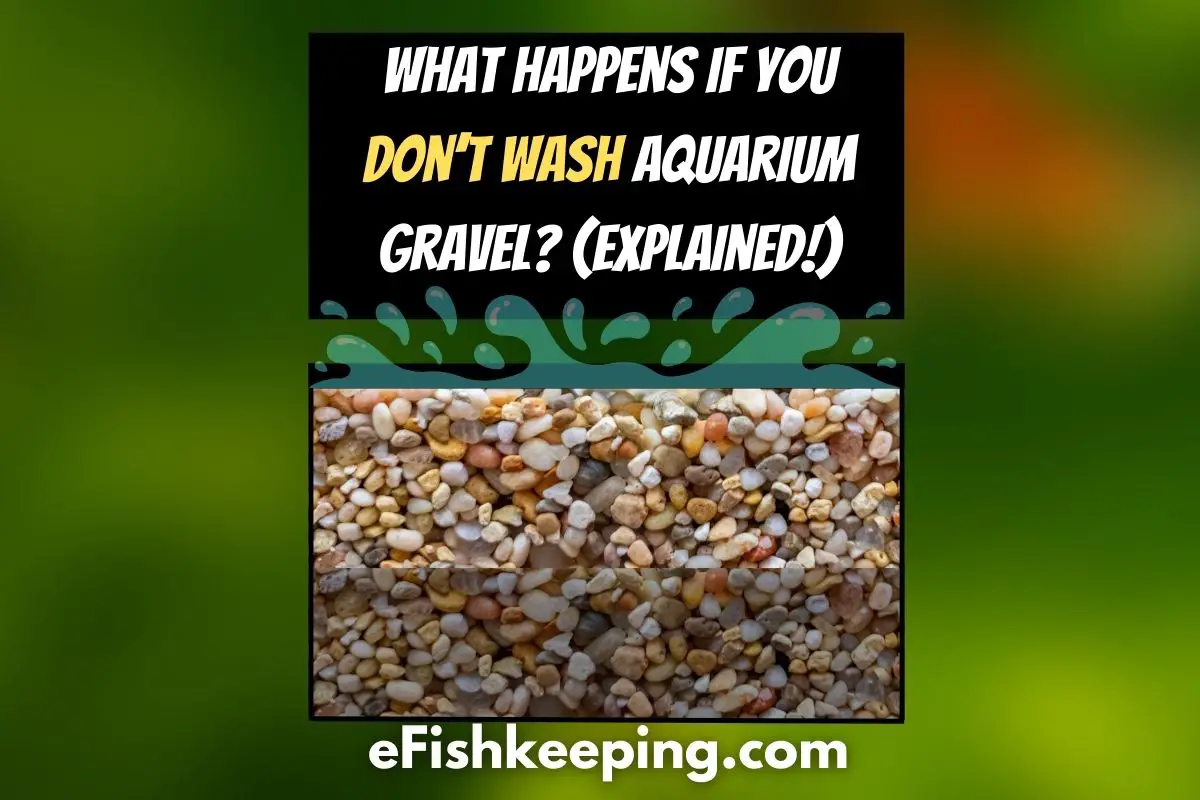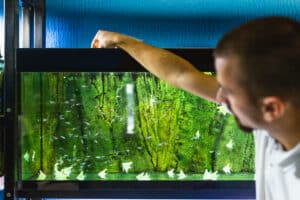Keeping your fish healthy and happy requires more than just feeding them and changing the water regularly.
And one important aspect of aquarium maintenance is regularly cleaning the gravel, which can easily become dirty if left unchecked.
But exactly what happens if you neglect to wash your aquarium gravel? Keep reading to find out.
What Happens if You Don’t Wash Aquarium Gravel?
If you don’t wash aquarium gravel, you’ll be letting toxic waste grow inside. All the food remnants and fish poop will settle in the gravel, eventually accumulating beyond reasonable limits.
The beneficial bacteria in your tank won’t grow sufficiently in contaminated or dirty gravel. This leads to high levels of ammonia and nitrite, which will affect the living conditions of your fish.
Additionally, harmful microorganisms and algae may be able to grow in your aquarium, disturbing the balance of the whole ecosystem.
Eventually, the water will get cloudy—an alarming sign of impurities or an imbalance in your aquarium.
How Often Should You Wash Aquarium Gravel?
Gravel requires regular cleaning for a lot of reasons. For one, uneaten fish food accumulates in the gravel, along with fish feces and other waste products.
Additionally, algae tend to grow on the gravel, and excess algae can disrupt the balance of the nitrogen cycle in your aquarium.
If your gravel is just the right size and the water circulation in your aquarium is decent, you won’t have to wash your gravel frequently. Once every month should be fine.
You’ll want to scrape the algae off from the tank’s walls, then use a vacuum to clean your gravel. Afterward, measure the levels of nitrate, ammonia, and pH in your tank to make sure the water parameters are steady.
Does Washing Aquarium Gravel Remove Beneficial Bacteria?
It depends on the vacuum you use for washing your gravel. Gravel vacuums should have tiny holes so they don’t take up all the bacteria and debris lying deep inside the gravel. Additionally, beneficial bacteria doesn’t stay on top of the gravel; it lives deep within the crevices and nooks.
So, even if the vacuum removes some of the beneficial bacteria, it’ll only be a tiny percentage. Chances are, it won’t mess with your aquarium’s health.
How to Wash Aquarium Gravel Using a Vacuum

Using a vacuum (link goes to Amazon) is the most efficient way to clean gravel. It uses hydrostatic pressure to suck the dirt and feces out, doing the process quickly and neatly.
Don’t worry about your fish being sucked into the vacuum. It should have a filter with tiny pores that allows it to suck in particles smaller than fish.
The following steps will guide you through using the vacuum cleaner:
- Remove the lid, then take out your air pump, heater, and filter
- Place an empty water bucket lower than the level of your tank
- Insert the sucking end of the vacuum inside your tank and the other end in the empty water bucket
- Use your vacuum to suck the waste from the gravel carefully
- Repeat the process until the vacuumed water is clear or one-third of the tank water is drained
Can You Wash Aquarium Gravel Without a Vacuum?
If you don’t have a vacuum or gravel siphon, you can still wash the gravel, although the results may not be as clean.
All you have to do is dip your hands inside the aquarium and stir the gravel slightly. Keep turning it over using your fingers, so the debris inside the deep crevices will get out. Now, when the dust appears in the water, drain half or a third of it, leaving the rest to keep the beneficial bacteria intact.
Replace the drained water with a new one, and adjust the parameters to keep the fish healthy.
This method isn’t as efficient as using a vacuum because not all of the debris will get out, but it’ll at least keep the aquarium healthy.
How to Keep Algae off Aquarium Gravel?
To keep algae off your gravel, your best bet is to cut off its feeding sources. Algae stick to your gravel and climb up the walls of your tanks for three things: phosphate, nitrate, and light.
If the algae are getting out of control, remove nitrate and phosphate from your aquarium for a while.
As for the light, washing your gravel with a vacuum should turn it over, messing with the amount of light the algae will receive.
If you clean your gravel regularly once a month, the algae should stay within reasonable limits. If it keeps growing, you can take the easy route and get a fish that feeds on algae.
How Often Should You Wash Aquarium Gravel if You Have Live Plants?
If you have live plants with deep roots inside the gravel, washing it frequently may not be the best option. You’ll be messing with the plants’ roots regularly, which may hinder their growth. You may also cut one of the roots accidentally while stirring the gravel to clean it.
In this case, your best option is to use a gravel siphon for cleaning. It’ll regularly wash the gravel, keeping it clean from the food waste, debris, and fish poop. At the same time, it won’t cause the plants any stress.
It’s worth noting, though, that you’ll have to carry out a deep cleaning once a year. Although the siphon will wash the gravel, it won’t go deep inside the crevices. So, once a year, clean the gravel thoroughly and scrape off all the algae around it, making sure not to harm the live plants.
Should You Wash New Gravel Before Adding It to the Aquarium?
Even if the manufacturer labels the gravel as pre-rinsed, transportation, storage conditions, and defective packaging can lead to unwanted material in your gravel.
If you add your gravel into your tank without washing it, that causes all the dust and dirt to be suspended in the water, making it look cloudy. Besides, the harmful microorganisms will all settle on the surface of your gravel and keep accumulating over time.
It’s always better to wash new gravel before adding it to the aquarium.
Suggested Reading: Can I Add Gravel After Water?
How to Clean Your Tank After Adding Unwashed Gravel in It?
In most cases, vacuuming will clear the water from the dust with the help of the filtration system.
You can perform a partial water change, then wait for the dust to settle down and start vacuuming the settled dirt in the gravel.
Although that might be enough to clear most of the dust and dirt, it won’t be efficient at getting rid of unwanted bacteria or discoloration caused by dye.
If the cloudiness of the water remains for more than one day, that means you probably need to take another approach.
In that case, I recommend draining the tank completely, washing the gravel thoroughly, then refilling the tank and starting a new nitrogen cycle.
Before transferring your fish to the aquarium, make sure it’s completely clear of toxins, and run regular tests on the water.
In Conclusion
Washing the gravel before adding it to your aquarium is an essential step.
If not washed thoroughly, it may contaminate your tank, disrupt the balance of the ecosystem, and harm your fish.
Clean your gravel regularly to get rid of accumulated waste and keep your fish healthy—once a month is enough if the water circulation in your tank is good. If you have live plants, you’ll have to deep-clean the tank once a year.
Hi! I’m Praveen Ghoshal, the founder of eFishkeeping.com. Inspired by my Dad, I got interested in fishkeeping when I was a kid. Since then, I have been involved with this hobby. Currently, I have 3 fish tanks at our home, and I enjoy this hobby with my full family. Read more about me here.







